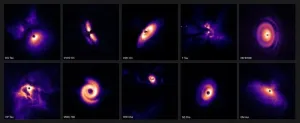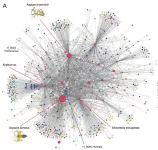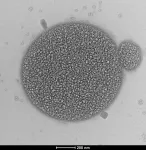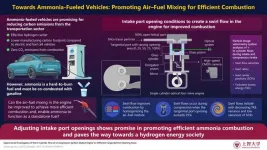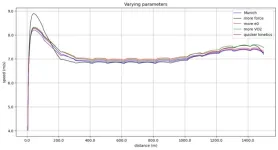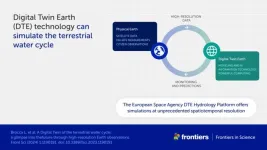(Press-News.org) In a series of studies, a team of astronomers has shed new light on the fascinating and complex process of planet formation. The stunning images, captured using the European Southern Observatory's Very Large Telescope (ESO’s VLT) in Chile, represent one of the largest ever surveys of planet-forming discs. The research brings together observations of more than 80 young stars that might have planets forming around them, providing astronomers with a wealth of data and unique insights into how planets arise in different regions of our galaxy.
“This is really a shift in our field of study,” says Christian Ginski, a lecturer at the University of Galway, Ireland, and lead author of one of three new papers published today in Astronomy & Astrophysics. “We’ve gone from the intense study of individual star systems to this huge overview of entire star-forming regions.”
To date more than 5000 planets have been discovered orbiting stars other than the Sun, often within systems markedly different from our own Solar System. To understand where and how this diversity arises, astronomers must observe the dust- and gas-rich discs that envelop young stars — the very cradles of planet formation. These are best found in huge gas clouds where the stars themselves are forming.
Much like mature planetary systems, the new images showcase the extraordinary diversity of planet-forming discs. “Some of these discs show huge spiral arms, presumably driven by the intricate ballet of orbiting planets,” says Ginski. “Others show rings and large cavities carved out by forming planets, while yet others seem smooth and almost dormant among all this bustle of activity,” adds Antonio Garufi, an astronomer at the Arcetri Astrophysical Observatory, Italian National Institute for Astrophysics (INAF), and lead author of one of the papers.
The team studied a total of 86 stars across three different star-forming regions of our galaxy: Taurus and Chamaeleon I, both around 600 light-years from Earth, and Orion, a gas-rich cloud about 1600 light-years from us that is known to be the birthplace of several stars more massive than the Sun. The observations were gathered by a large international team, comprising scientists from more than 10 countries.
The team was able to glean several key insights from the dataset. For example, in Orion they found that stars in groups of two or more were less likely to have large planet-forming discs. This is a significant result given that, unlike our Sun, most stars in our galaxy have companions. As well as this, the uneven appearance of the discs in this region suggests the possibility of massive planets embedded within them, which could be causing the discs to warp and become misaligned.
While planet-forming discs can extend for distances hundreds of times greater than the distance between Earth and the Sun, their location several hundreds of light-years from us makes them appear as tiny pinpricks in the night sky. To observe the discs, the team employed the sophisticated Spectro-Polarimetric High-contrast Exoplanet REsearch instrument (SPHERE) mounted on ESO’s VLT. SPHERE’s state-of-the-art extreme adaptive optics system corrects for the turbulent effects of Earth’s atmosphere, yielding crisp images of the discs. This meant the team were able to image discs around stars with masses as low as half the mass of the Sun, which are typically too faint for most other instruments available today. Additional data for the survey were obtained using the VLT’s X-shooter instrument, which allowed astronomers to determine how young and how massive the stars are. The Atacama Large Millimeter/submillimeter Array (ALMA), in which ESO is a partner, on the other hand, helped the team understand more about the amount of dust surrounding some of the stars.
As technology advances, the team hopes to delve even deeper into the heart of planet-forming systems. The large 39-metre mirror of ESO’s forthcoming Extremely Large Telescope (ELT), for example, will enable the team to study the innermost regions around young stars, where rocky planets like our own might be forming.
For now, these spectacular images provide researchers with a treasure trove of data to help unpick the mysteries of planet formation. “It is almost poetic that the processes that mark the start of the journey towards forming planets and ultimately life in our own Solar System should be so beautiful,” concludes Per-Gunnar Valegård, a doctoral student at the University of Amsterdam, the Netherlands, who led the Orion study. Valegård, who is also a part-time teacher at the International School Hilversum in the Netherlands, hopes the images will inspire his pupils to become scientists in the future.
More information
This research was presented in three papers to appear in Astronomy & Astrophysics. The data presented were gathered as part of the SPHERE consortium guaranteed time programme, as well as the DESTINYS (Disk Evolution Study Through Imaging of Nearby Young Stars) ESO Large Programme.
“The SPHERE view of the Chamaeleon I star-forming region: The full census of planet-forming disks with GTO and DESTINYS programs” (https://www.aanda.org/10.1051/0004-6361/202244005)
The team is composed of C. Ginski (University of Galway, Ireland; Leiden Observatory, Leiden University, the Netherlands [Leiden]; Anton Pannekoek Institute for Astronomy, University of Amsterdam, the Netherlands [API]), R. Tazaki (API), M. Benisty (Univ. Grenoble Alpes, CNRS, IPAG, France [Grenoble]), A. Garufi (INAF, Osservatorio Astrofisico di Arcetri, Italy), C. Dominik (API), Á. Ribas (European Southern Observatory, Chile [ESO Chile]), N. Engler (ETH Zurich, Institute for Particle Physics and Astrophysics, Switzerland), J. Hagelberg (Geneva Observatory, University of Geneva, Switzerland), R. G. van Holstein (ESO Chile), T. Muto (Division of Liberal Arts, Kogakuin University, Japan), P. Pinilla (Max-Planck-Institut für Astronomie, Germany [MPIA]; Mullard Space Science Laboratory, University College London, UK), K. Kanagawa (Department of Earth and Planetary Sciences, Tokyo Institute of Technology, Japan), S. Kim (Department of Astronomy, Tsinghua University, China), N. Kurtovic (MPIA), M. Langlois (Centre de Recherche Astrophysique de Lyon, CNRS, UCBL, France), J. Milli (Grenoble), M. Momose (College of Science, Ibaraki University, Japan [Ibaraki]), R. Orihara (Ibaraki), N. Pawellek (Department of Astrophysics, University of Vienna, Austria), T. O. B. Schmidt (Hamburger Sternwarte, Germany), F. Snik (Leiden), and Z. Wahhaj (ESO Chile).
“The SPHERE view of the Taurus star-forming region: The full census of planet-forming disks with GTO and DESTINYS programs” (https://www.aanda.org/10.1051/0004-6361/202347586)
The team is composed of A. Garufi (INAF, Osservatorio Astrofisico di Arcetri, Italy [INAF Arcetri]), C. Ginski (University of Galway, Ireland), R. G. van Holstein (European Southern Observatory, Chile [ESO Chile]), M. Benisty (Laboratoire Lagrange, Université Côte d’Azur, Observatoire de la Côte d’Azur, CNRS, France; Univ. Grenoble Alpes, CNRS, IPAG, France [Grenoble]), C. F. Manara (European Southern Observatory, Germany), S. Pérez (Millennium Nucleus on Young Exoplanets and their Moons [YEMS]; Departamento de Física, Universidad de Santiago de Chile, Chile [Santiago]), P. Pinilla (Mullard Space Science Laboratory, University College London, UK), A. Ribas (Institute of Astronomy, University of Cambridge, UK), P. Weber (YEMS, Santiago), J. Williams (Institute for Astronomy, University of Hawai‘i, USA), L. Cieza (Instituto de Estudios Astrofísicos, Facultad de Ingeniería y Ciencias, Universidad Diego Portales, Chile [Diego Portales]; YEMS), C. Dominik (Anton Pannekoek Institute for Astronomy, University of Amsterdam, the Netherlands [API]), S. Facchini (Dipartimento di Fisica, Università degli Studi di Milano, Italy), J. Huang (Department of Astronomy, Columbia University, USA), A. Zurlo (Diego Portales; YEMS), J. Bae (Department of Astronomy, University of Florida, USA), J. Hagelberg (Observatoire de Genève, Université de Genève, Switzerland), Th. Henning (Max Planck Institute for Astronomy, Germany [MPIA]), M. R. Hogerheijde (Leiden Observatory, Leiden University, the Netherlands; API), M. Janson (Department of Astronomy, Stockholm University, Sweden), F. Ménard (Grenoble), S. Messina (INAF - Osservatorio Astrofisico di Catania, Italy), M. R. Meyer (Department of Astronomy, The University of Michigan, USA), C. Pinte (School of Physics and Astronomy, Monash University, Australia; Grenoble), S. Quanz (ETH Zürich, Department of Physics, Switzerland [Zürich]), E. Rigliaco (Osservatorio Astronomico di Padova, Italy [Padova]), V. Roccatagliata (INAF Arcetri), H. M. Schmid (Zürich), J. Szulágyi (Zürich), R. van Boekel (MPIA), Z. Wahhaj (ESO Chile), J. Antichi (INAF Arcetri), A. Baruffolo (Padova), and T. Moulin (Grenoble).
“Disk Evolution Study Through Imaging of Nearby Young Stars (DESTINYS): The SPHERE view of the Orion star-forming region” (https://www.aanda.org/10.1051/0004-6361/202347452)
The team is composed of P.-G. Valegård (Anton Pannekoek Institute for Astronomy, University of Amsterdam, the Netherlands [API]), C. Ginski (University of Galway, Ireland), A. Derkink (API), A. Garufi (INAF, Osservatorio Astrofisico di Arcetri, Italy), C. Dominik (API), Á. Ribas (Institute of Astronomy, University of Cambridge, UK), J. P. Williams (Institute for Astronomy, University of Hawai‘i, USA), M. Benisty (University of Grenoble Alps, CNRS, IPAG, France), T. Birnstiel (University Observatory, Faculty of Physics, Ludwig-Maximilians-Universität München, Germany [LMU]; Exzellenzcluster ORIGINS, Germany), S. Facchini (Dipartimento di Fisica, Università degli Studi di Milano, Italy), G. Columba (Department of Physics and Astronomy "Galileo Galilei" - University of Padova, Italy; INAF – Osservatorio Astronomico di Padova, Italy), M. Hogerheijde (API; Leiden Observatory, Leiden University, the Netherlands [Leiden]), R. G. van Holstein (European Southern Observatory, Chile), J. Huang (Department of Astronomy, Columbia University, USA), M. Kenworthy (Leiden), C. F. Manara (European Southern Observatory, Germany), P. Pinilla (Mullard Space Science Laboratory, University College London, UK), Ch. Rab (LMU; Max-Planck-Institut für extraterrestrische Physik, Germany), R. Sulaiman (Department of Physics, American University of Beirut, Lebanon), A. Zurlo (Instituto de Estudios Astrofísicos, Facultad de Ingeniería y Ciencias, Universidad Diego Portales, Chile; Escuela de Ingeniería Industrial, Facultad de Ingeniería y Ciencias, Universidad Diego Portales, Chile; Millennium Nucleus on Young Exoplanets and their Moons).
The European Southern Observatory (ESO) enables scientists worldwide to discover the secrets of the Universe for the benefit of all. We design, build and operate world-class observatories on the ground — which astronomers use to tackle exciting questions and spread the fascination of astronomy — and promote international collaboration for astronomy. Established as an intergovernmental organisation in 1962, today ESO is supported by 16 Member States (Austria, Belgium, Czechia, Denmark, France, Finland, Germany, Ireland, Italy, the Netherlands, Poland, Portugal, Spain, Sweden, Switzerland and the United Kingdom), along with the host state of Chile and with Australia as a Strategic Partner. ESO’s headquarters and its visitor centre and planetarium, the ESO Supernova, are located close to Munich in Germany, while the Chilean Atacama Desert, a marvellous place with unique conditions to observe the sky, hosts our telescopes. ESO operates three observing sites: La Silla, Paranal and Chajnantor. At Paranal, ESO operates the Very Large Telescope and its Very Large Telescope Interferometer, as well as survey telescopes such as VISTA. Also at Paranal ESO will host and operate the Cherenkov Telescope Array South, the world’s largest and most sensitive gamma-ray observatory. Together with international partners, ESO operates ALMA on Chajnantor, a facility that observes the skies in the millimetre and submillimetre range. At Cerro Armazones, near Paranal, we are building “the world’s biggest eye on the sky” — ESO’s Extremely Large Telescope. From our offices in Santiago, Chile we support our operations in the country and engage with Chilean partners and society.
The Atacama Large Millimeter/submillimeter Array (ALMA), an international astronomy facility, is a partnership of ESO, the U.S. National Science Foundation (NSF) and the National Institutes of Natural Sciences (NINS) of Japan in cooperation with the Republic of Chile. ALMA is funded by ESO on behalf of its Member States, by NSF in cooperation with the National Research Council of Canada (NRC) and the National Science and Technology Council (NSTC) in Taiwan and by NINS in cooperation with the Academia Sinica (AS) in Taiwan and the Korea Astronomy and Space Science Institute (KASI). ALMA construction and operations are led by ESO on behalf of its Member States; by the National Radio Astronomy Observatory (NRAO), managed by Associated Universities, Inc. (AUI), on behalf of North America; and by the National Astronomical Observatory of Japan (NAOJ) on behalf of East Asia. The Joint ALMA Observatory (JAO) provides the unified leadership and management of the construction, commissioning and operation of ALMA.
Links
Research paper
Photos of the VLT
Find out more about ESO's Extremely Large Telescope on our dedicated website and press kit
For journalists: subscribe to receive our releases under embargo in your language
For scientists: got a story? Pitch your research
Contacts
Christian Ginski
University of Galway
Galway, Ireland
Email: christian.ginski@universityofgalway.ie
Antonio Garufi
INAF’s Arcetri Astrophysical Observatory
Florence, Italy
Email: antonio.garufi@inaf.it
Per-Gunnar Valegård
University of Amsterdam
Email: p.g.valegard@uva.nl
Bárbara Ferreira
ESO Media Manager
Garching bei München, Germany
Tel: +49 89 3200 6670
Cell: +49 151 241 664 00
Email: press@eso.org
END
Groundbreaking survey reveals secrets of planet birth around dozens of stars
2024-03-05
ELSE PRESS RELEASES FROM THIS DATE:
Food web flexibility through time
2024-03-05
A theoretical experiment characterized the network architecture of a species-rich ecosystem over 8 months. Predator–prey interaction networks play a key role in structuring ecosystems, but ecological research has often treated such networks as static, despite the broadly accepted understanding of ecosystems as dynamic. Hirokazu Toju and colleagues followed the complex food webs between 50 predatory spider species and 974 prey species, including midges, springtails, mosquitoes, and aphids, for eight months. The studied ecosystem is a warm-temperate grassland ...
One way to improve a fusion reaction: Use weaknesses as strengths
2024-03-05
In the Japanese art of Kintsugi, an artist takes the broken shards of a bowl and fuses them back together with gold to make a final product more beautiful than the original.
That idea is inspiring a new approach to managing plasma, the super-hot state of matter, for use as a power source. Scientists are using the imperfections in magnetic fields that confine a reaction to improve and enhance the plasma in an approach outlined in a new paper in the journal Nature Communications.
“This approach allows you to maintain ...
Predicting who will experience aesthetic chills
2024-03-05
Researchers built a model that can predict with 73.5% accuracy when a person will experience aesthetic chills: shivers, goosebumps, or a feeling of cold down the neck or spine elicited by aesthetic stimuli, such as beautiful music or an inspirational speech. Felix Schoeller and colleagues surveyed 2,937 people from Southern California, through an online platform, gathering data on their personalities, demographic backgrounds, and emotional state. The authors then exposed survey respondents to 40 emotion-evoking audiovisual clips sourced from social media, selected because commenters had reported experiencing aesthetic chills while watching and listening. ...
Possible ‘Trojan Horse’ found for treating stubborn bacterial infections
2024-03-05
PULLMAN, Wash. – Bacteria can be tricked into sending death signals to stop the growth of their slimy, protective homes that lead to deadly infections, a new study demonstrates.
The discovery by Washington State University researchers could someday be harnessed as an alternative to antibiotics for treating difficult infections. Reporting in the journal, Biofilm, the researchers used the messengers, which they named death extracellular vesicles (D-EVs), to reduce growth of the bacterial communities by up to 99.99% in laboratory experiments.
“Adding the death extracellular vesicles to ...
AI art and human creativity
2024-03-05
Text-to-image generative AI systems like Midjourney, Stable Diffusion, and DALL-E can produce images based on text prompts that, had they been produced by humans, would plausibly be judged as “creative.” Some artists have argued that these programs are a threat to human creativity. If AI comes to be relied on to produce most new visual works, drawing on what has been done before, creative progress could stagnate. Eric Zhou and Dokyun “DK” Lee investigated the impact of text-to-image AI tools on human creativity, seeking to understand ...
Decoding cryptocurrency regulation in the legibility framework
2024-03-05
Since its introduction, cryptocurrency governance has been one of the most controversial global financial topics. While some countries have established elaborate regulations for cryptocurrencies, many countries are still reluctant to oversee the markets, and some have outright banned them. Most studies suggest that public agencies naturally want to regulate markets and bring them into their purview. However, the significant differences in cryptocurrency regulation over the world call this view into question. Moreover, these differences cannot be explained by the development ...
Ammonia-powered engines: A path to cleaner and more efficient transportation
2024-03-05
While the transportation sector has witnessed a dramatic shift toward electric vehicles (EVs), the idea of using hydrogen as a clean and efficient fuel for transportation has been explored for many decades. These vehicles emit water on combustion, and since they are based on the production of existing engine vehicles, they are expected to have a lower manufacturing carbon footprint than EVs. However, storing and transporting hydrogen requires high pressures and low temperatures, which are energy-intensive processes. To address this, ammonia has ...
Running performance helped by mathematical research
2024-03-05
How to optimise running? A new mathematical model1 has shown, with great precision, the impact that physiological and psychological parameters have on running performance and provides tips for optimised training. The model grew out of research conducted by a French-British team including two CNRS researchers2, the results of which will appear on March 5th 2024 in the journal Frontiers in Sports and Active Living.
This innovative model was developed thanks to extremely precise data3 from the performances of Matthew Hudson-Smith (400m), Femke Bol (400m), and ...
New ‘digital twin’ Earth technology could help predict water-based natural disasters before they strike
2024-03-05
The water cycle looks simple in theory — but human impacts, climate change, and complicated geography mean that in practice, floods and droughts remain hard to predict. To model water on Earth, you need incredibly high-resolution data across an immense expanse, and you need modeling sophisticated enough to account for everything from snowcaps on mountains to soil moisture in valleys. Now, scientists funded by the European Space Agency have made a tremendous step forward by building the most detailed models created to date.
“Simulating ...
Sweetened drinks linked to atrial fibrillation risk
2024-03-05
Research Highlights:
An analysis of health data in the UK Biobank found a 20% higher risk of irregular heart rhythm, known as atrial fibrillation, among people who said they drank two liters or more per week (about 67 ounces) of artificially sweetened drinks. The risk was 10% higher among people who said they drank similar amounts of sugar-sweetened beverages.
Drinking one liter (about 34 ounces) or less of pure juice per week, such as 100% orange or vegetable juice, was associated with an 8% lower risk of atrial fibrillation.
The observational study could not confirm that sweetened drinks cause irregular heart rhythms.
Embargoed ...
